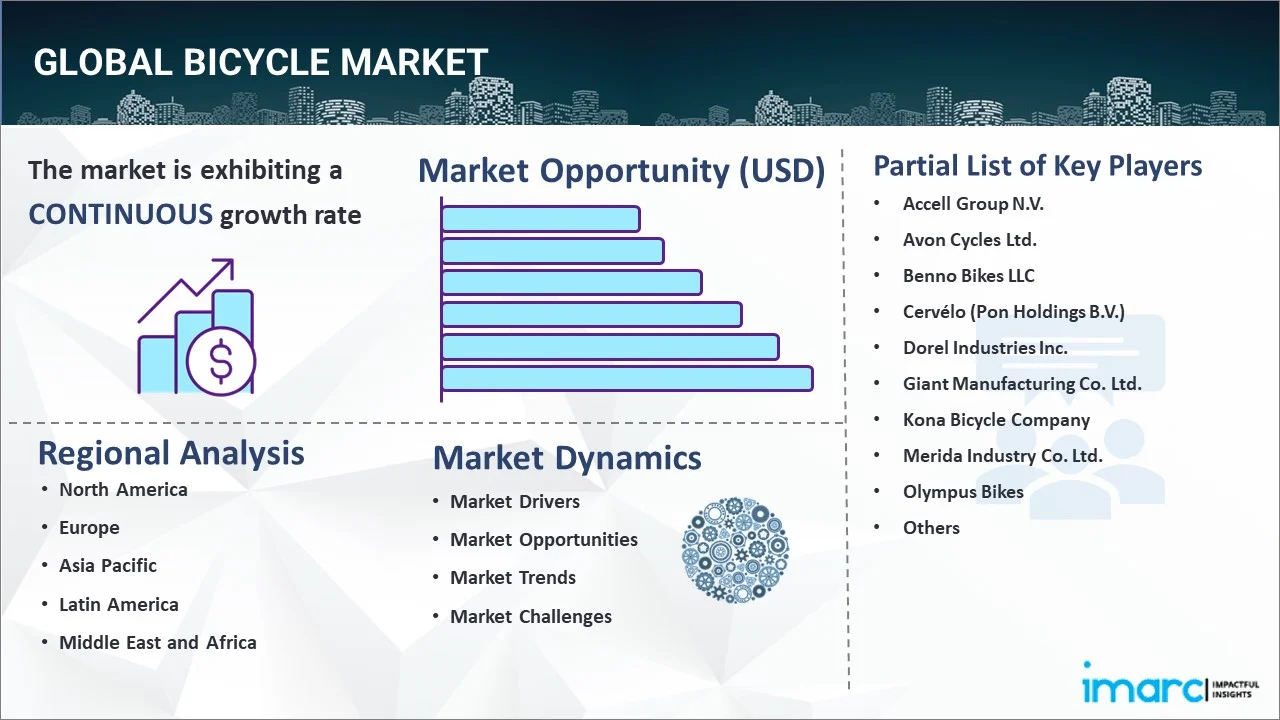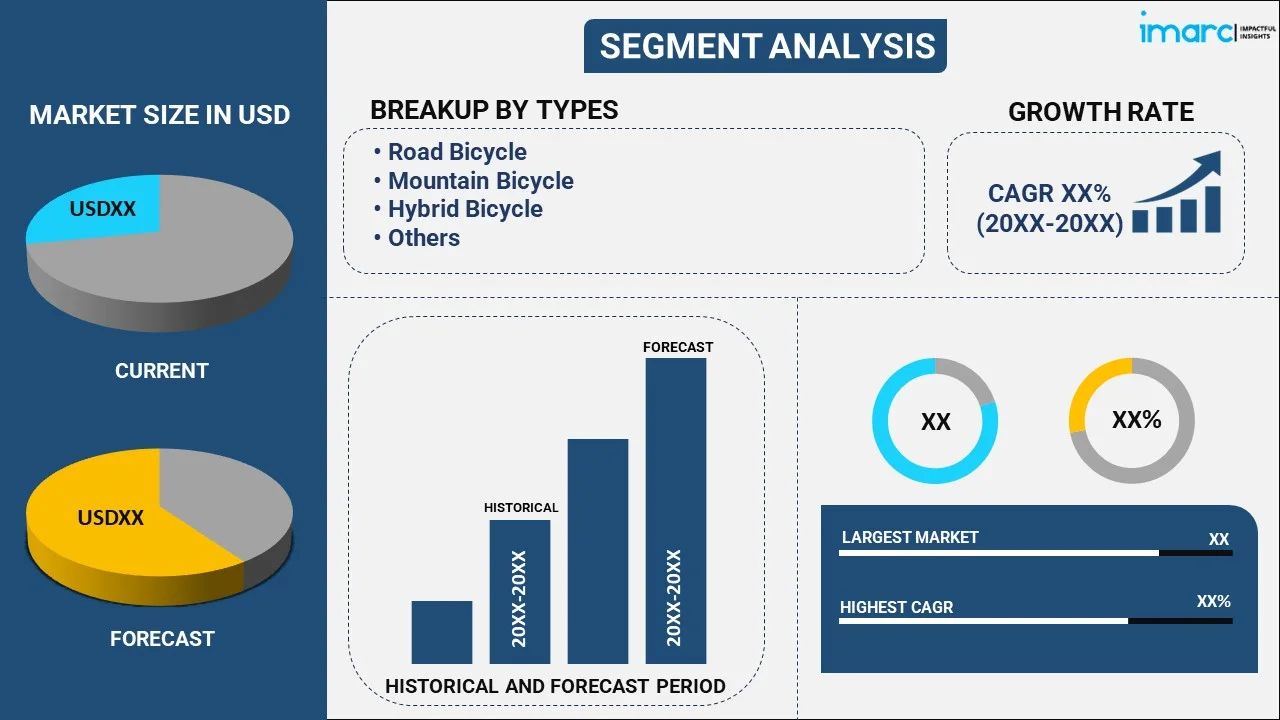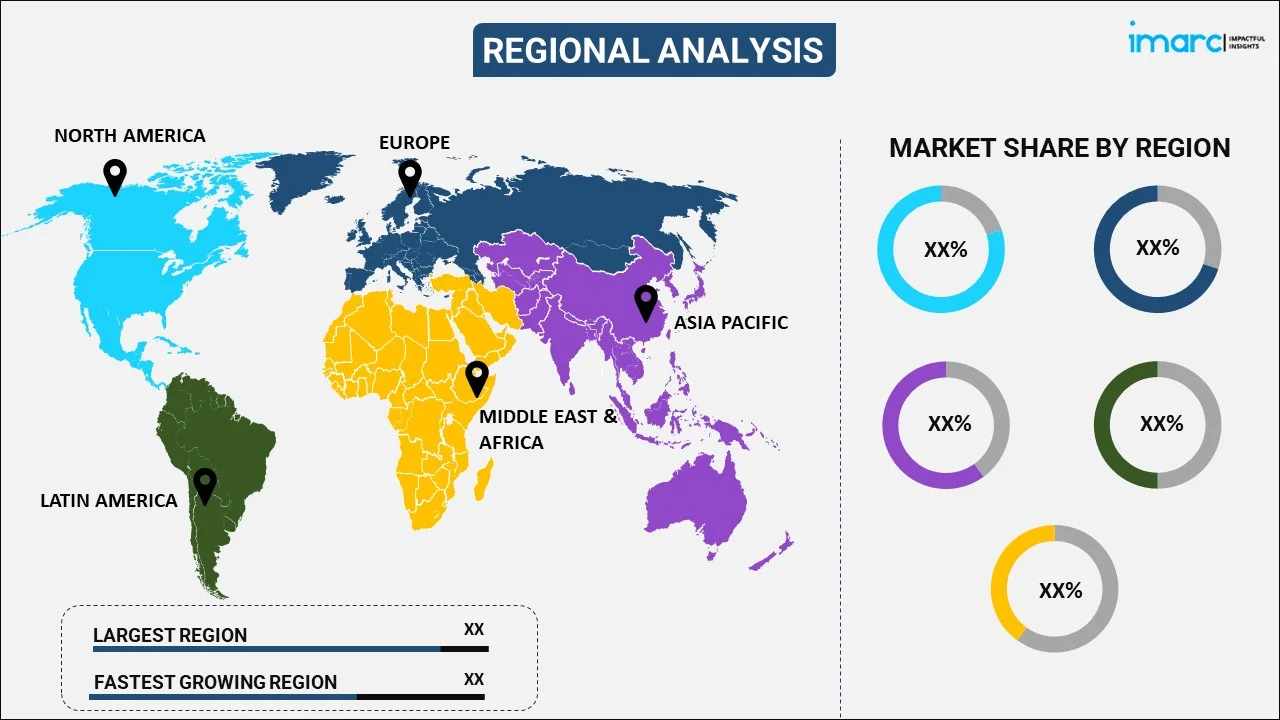
Bicycle Market Report by Type (Road Bicycle, Mountain Bicycle, Hybrid Bicycle, and Others), Technology (Electric, Conventional), Price (Premium, Mid-Range, Low-Range), Distribution Channel (Online Stores, Offline Stores), End User (Men, Women, Kids), and Region 2025-2033
Global Bicycle Market:
The global bicycle market size reached USD 67.4 Billion in 2024. Looking forward, IMARC Group expects the market to reach USD 102.1 Billion by 2033, exhibiting a growth rate (CAGR) of 4.48% during 2025-2033. The launch of favorable policies by government bodies to minimize carbon emissions levels that are released from vehicles, coupled with the development of electric bicycles, is primarily bolstering the market share.
|
Report Attribute
|
Key Statistics
|
|---|---|
|
Base Year
|
2024
|
|
Forecast Years
|
2025-2033
|
|
Historical Years
|
2019-2024
|
|
Market Size in 2024
|
USD 67.4 Billion |
|
Market Forecast in 2033
|
USD 102.1 Billion |
| Market Growth Rate 2025-2033 | 4.48% |
Global Bicycle Market Analysis:
- Major Market Drivers: The rising adoption of bicycles, owing to the increasing traffic congestion and the elevating need for reducing the availability of parking space, especially in metropolitan cities, is augmenting the bicycle market demand. Moreover, various factors, including government initiatives, the inflating levels of pollution, and the advent of technology, are further escalating the bicycle market growth.
- Key Market Trends: The elevating emphasis of individuals on sustainability, the widespread adoption of eco-friendly transportation options, and changing consumer lifestyle preferences are emerging trends stimulating the bicycle market revenue. Moreover, bicycles are increasingly utilized as part of the solution to urban mobility challenges. Consequently, cities are investing in bike lanes and bike-sharing programs, thereby propelling the bicycle market value.
- Geographical Trends: According to bicycle market research, countries across Europe have witnessed well-developed cycling infrastructures, thereby catalyzing the market growth in the region. Apart from this, bicycle-sharing companies in China are expanding their presence in countries, including India and Australia, to elevate their operations, which is further augmenting the market growth.
- Competitive Landscape: According to the bicycle market overview, some of the major market players in the global market include Accell Group N.V., Avon Cycles Ltd., Benno Bikes LLC, Cervélo (Pon Holdings B.V.), Dorel Industries Inc., Giant Manufacturing Co. Ltd., Kona Bicycle Company, Merida Industry Co. Ltd., Olympus Bikes, SCOTT Sports SA (Youngone Corporation), Specialized Bicycle Components Inc., and Trek Bicycle Corporation (Roth Distributing Co. Inc.), among many others.
- Challenges and Opportunities: Inadequate cycling infrastructures, such as bike lanes and parking facilities, can discourage individuals from cycling, particularly in urban areas where traffic congestion is a concern. However, the growing consumer awareness towards the health benefits of cycling as a form of exercise and recreation is anticipated to fuel the global market over the forecasted period.

Global Bicycle Market Trends:
Growing Adoption of E-Bikes
The escalating prices of fuel and the rising traffic congestion, especially in urban and metropolitan areas, are increasing the preferences of consumers towards electric bicycles. Besides this, the growing number of individuals are shifting to cities, owing to the availability of numerous opportunities and ease in access to transport, which will further lead to more traffic congestion. According to the United Nations Department of Economic and Social Affair, 68% of the global population will live in urban areas by 2050. This is expected to increase the number of vehicles on the road, thereby causing difficulty in mobility. Moreover, e-bikes make cycling more accessible to a wider range of people, including those who may not be able to use traditional bikes due to physical limitations or fitness levels. The electric assistance helps riders travel longer distances and tackle hills with ease, making them a practical transportation option for urban commuting and recreational riding. Consequently, government authorities are taking favorable measures to promote the use of bicycles, which is expected to augment the market growth over the forecasted period. For example, the World Health Organization (WHO) and the United Nations (UN) declared 3rd June as World Bicycle Day to recognize the contribution of bicycles towards affordable and eco-friendly transport mechanisms.
Rising Government Initiatives
According to the recent bicycle market outlook, government authorities are investing significantly in the development of cycling infrastructures, such as dedicated bike lanes, bike-sharing programs, and secure bike parking facilities. These infrastructural improvements make cycling safer and more convenient, encouraging more individuals to take up cycling. Moreover, the implementation of legislation and policies to promote cycling, such as bike-friendly urban planning, regulations to ensure cyclist safety, and incentives for businesses to support cycling among employees. These measures create a more supportive environment for cycling. For instance, according to a recent report published by the Observer Research Foundation, various initiatives by government bodies to provide schoolgirls bicycles have been started in West Bengal and Bihar, and the results have been praised for closing the gender gap in secondary education. Similarly, the Saboojsathi program launched by regulatory bodies in West Bengal won the World Summit on the Information Society (WSIS) Award in 2019, under the e-governance category, on account of its social impact among school going children. Moreover, governments of various countries offer financial incentives to encourage cycling, such as subsidies for purchasing bicycles or e-bikes, tax breaks for cyclists, and grants for cycling infrastructure projects. These incentives help to reduce the cost barrier associated with cycling. For instance, the government in Scotland introduced a scheme to distribute free bicycles to school-age children who cannot afford them.
Growing Focus on Health and Wellness
Cycling aids in improving fitness levels, strengthening muscles, and burning calories. As individuals become more health-conscious, they are turning to activities like cycling to stay active and maintain their fitness. For instance, Samagra Shiksha in Delhi has launched a wellness club to educate students in government-run schools in classes 9 through 12 about leading healthy lives. Besides this, as the prevalence of cardiovascular diseases increases, more people are turning to cycling to improve their health and reduce their risk. For instance, according to a recent report published by the World Health Federation, cardiovascular illnesses continued to afflict over half a billion people worldwide, accounting for 20.5 million deaths in 2021. As a result, bicycles find extensive applications for fitness purposes across the globe.
Growing Number of Cycling Events
The increasing inclination towards adventurous activities is inflating the adoption of bicycles in trekking and recreational events, thereby proliferating the growth of the market. Moreover, various public figures and celebrities are participating and promoting cycling, which is escalating the demand for bicycles. Moreover, these events promote health and fitness by encouraging people to set goals and train for a specific event. Participants often experience improved fitness levels and a sense of accomplishment upon completing the event. For example, according to the study done in 2022 by the Allgemeiner Deutscher Fahrrad-Club (ADFC), around 96% of the respondents said that” they rode the bikes in Germany.’’ Furthermore, as per the Irish Sports Council, in 2022, Sport Ireland allocated around €520,000 to Cycling Ireland with the aim of motivating customers to engage in a range of cycling-related activities in the country. The ultimate objective of the event was to enhance the city's acceptance of bicycles and raise awareness of them. Such awareness-raising initiatives support the bicycle market share.
Bicycle Industry Segmentation:
IMARC Group provides an analysis of the key trends in each segment of the market, along with forecasts at the global, regional, and country levels for 2025-2033. Our report has categorized the market based on type, technology, price, distribution channel, and end user.
Breakup by Type:

- Road Bicycle
- Mountain Bicycle
- Hybrid Bicycle
- Others
The report has provided a detailed breakup and analysis of the market based on the type. This includes road bicycle, mountain bicycle, hybrid bicycle, others.
Mountain bicycles are extensively used in trekking, owing to the rising penetration towards adventure activities. Moreover, the majority of the population is switching towards the road and hybrid bicycles to commute shorter distances. This diverse range of product variants allows retailers and manufacturers to target specific consumer segments, thereby meeting the unique demands of numerous cycling enthusiasts.
Breakup by Technology:
- Electric
- Conventional
The report has provided a detailed breakup and analysis of the market based on the technology. This includes electric and conventional.
Conventional bicycles provide an excellent means of exercise, which helps to improve cardiovascular health, muscle strength, overall fitness, etc. Furthermore, e-bikes can reach higher speeds with less effort, which can make commuting faster and more convenient.
Breakup by Price:
- Premium
- Mid-Range
- Low-Range
The report has provided a detailed breakup and analysis of the market based on the price. This includes premium, mid-range, and low-range.
The demand for bicycles across premium, mid, and low ranges vary based on several factors, including economic conditions, consumer preferences, and trends in cycling.
Breakup by Distribution Channel:
- Online Stores
- Offline Stores
The report has provided a detailed breakup and analysis of the market based on the distribution channel. This includes online stores and offline stores.
The sale of bicycles is increasing in both online and offline stores, as they cater to the needs of the consumers depending upon their preferences. Online bicycle stores offer the convenience of browsing and purchasing bikes from the comfort of home, 24/7, without the need to visit a physical store. Moreover, the growing penetration of high-speed internet is encouraging vendors to sell their products via online platforms, including Amazon, Ali Express, Flipkart, etc. On the other hand, offline stores allow customers to physically inspect and test ride bicycles before making a purchase, providing a tactile shopping experience.
Breakup by End User:
- Men
- Women
- Kids
The report has provided a detailed breakup and analysis of the market based on the end-user. This includes men, women, and kids.
The elevating usage of bicycles among men, women, and kids is based on various factors including comfort, safety, trends, commuting and transportation choices, etc. As such, the number of men riding bicycles is higher than women and kids. According to the statistical data presented by the Department for Transport U.K., in 2019, on average, the U.K. male population made 25 cycling trips in a year than 10 cycling trips by the women in the same year.
Breakup by Region:

- North America
- United States
- Canada
- Asia-Pacific
- China
- Japan
- India
- South Korea
- Australia
- Indonesia
- Others
- Europe
- Germany
- France
- United Kingdom
- Italy
- Spain
- Russia
- Others
- Latin America
- Brazil
- Mexico
- Others
- Middle East and Africa
The report has also provided a comprehensive analysis of all the major regional markets, which include North America (the United States and Canada); Europe (Germany, France, the United Kingdom, Italy, Spain, Russia, and others); Asia Pacific (China, Japan, India, South Korea, Australia, Indonesia, and others); Latin America (Brazil, Mexico, and others); and the Middle East and Africa.
Countries, including Japan, Singapore, China, etc., are emphasizing on building necessary infrastructures to support and encourage bicycle commutation. Some of the cities in Japan, such as Tokyo, are known for their lowest accident rates and are hence considered ideal cities for urban bicycling. Moreover, bicycle-sharing companies in China are extensively targeting countries, such as Australia and India, to expand their operations, which is expected to bolster the demand for bicycles over the forecasted period.
Leading Key Players in the Bicycle Industry:
The market research report has provided a comprehensive analysis of the competitive landscape. Detailed profiles of all major companies have also been provided. Some of the key players in the market include:
- Accell Group N.V.
- Avon Cycles Ltd.
- Benno Bikes LLC
- Cervélo (Pon Holdings B.V.)
- Dorel Industries Inc.
- Giant Manufacturing Co. Ltd.
- Kona Bicycle Company
- Merida Industry Co. Ltd.
- Olympus Bikes
- SCOTT Sports SA (Youngone Corporation)
- Specialized Bicycle Components Inc.
- Trek Bicycle Corporation (Roth Distributing Co. Inc.)
(Please note that this is only a partial list of the key players, and the complete list is provided in the report.)
Global Bicycle Market News:
- April 2024: Electric vehicle manufacturer LOBO EV Technologies Ltd. has signed a strategic partnership with Serbian distributor CSM2017 Doo to increase its market share in Eastern Europe. The collaboration centers on the CSM-01 e-bike, in line with the growing need for environmentally friendly mobility in the area.
- April 2024: In France, Yamaha Motor Manufacturing Europe SAS (YMME) has commenced production of an electrically power-assisted bicycle.
- April 2024: Free & Easy and State Bicycle Co. have launched the iconic Klunker bicycle, along with exclusive custom grips and frame bags.
Bicycle Market Report Scope:
| Report Features | Details |
|---|---|
| Base Year of the Analysis | 2024 |
| Historical Period | 2019-2024 |
| Forecast Period | 2025-2033 |
| Units | Billion USD |
| Segment Coverage | Type, Technology, Price, Distribution Channel, End User, Region |
| Region Covered | Asia Pacific, Europe, North America, Latin America, Middle East and Africa |
| Countries Covered | United States, Canada, Germany, France, United Kingdom, Italy, Spain, Russia, China, Japan, India, South Korea, Australia, Indonesia, Brazil, Mexico |
| Companies Covered | Accell Group N.V., Avon Cycles Ltd., Benno Bikes LLC, Cervélo (Pon Holdings B.V.), Dorel Industries Inc., Giant Manufacturing Co. Ltd., Kona Bicycle Company, Merida Industry Co. Ltd., Olympus Bikes, SCOTT Sports SA (Youngone Corporation), Specialized Bicycle Components Inc., Trek Bicycle Corporation (Roth Distributing Co. Inc.), etc. |
| Customization Scope | 10% Free Customization |
| Post-Sale Analyst Support | 10-12 Weeks |
| Delivery Format | PDF and Excel through Email (We can also provide the editable version of the report in PPT/Word format on special request) |
Key Questions Answered in This Report:
- How has the global bicycle market performed so far and how will it perform in the coming years?
- What has been the impact of COVID-19 on the global bicycle market?
- What are the key regional markets?
- What is the breakup of the market based on the type?
- What is the breakup of the market based on the technology?
- What is the breakup of the market based on the price?
- What is the breakup of the market based on the distribution channel?
- What is the breakup of the market based on the end user?
- What are the various stages in the value chain of the industry?
- What are the key driving factors and challenges in the industry?
- What is the structure of the global bicycle market and who are the key players?
- What is the degree of competition in the industry?
Key Benefits for Stakeholders:
- IMARC’s industry report offers a comprehensive quantitative analysis of various market segments, historical and current market trends, market forecasts, and dynamics of the bicycle market from 2019-2033.
- The research report provides the latest information on the market drivers, challenges, and opportunities in the global bicycle market.
- The study maps the leading, as well as the fastest-growing, regional markets. It further enables stakeholders to identify the key country-level markets within each region.
- Porter's five forces analysis assists stakeholders in assessing the impact of new entrants, competitive rivalry, supplier power, buyer power, and the threat of substitution. It helps stakeholders to analyze the level of competition within the bicycle industry and its attractiveness.
- The competitive landscape allows stakeholders to understand their competitive environment and provides insight into the current positions of key players in the market.
Need more help?
- Speak to our experienced analysts for insights on the current market scenarios.
- Include additional segments and countries to customize the report as per your requirement.
- Gain an unparalleled competitive advantage in your domain by understanding how to utilize the report and positively impacting your operations and revenue.
- For further assistance, please connect with our analysts.
 Inquire Before Buying
Inquire Before Buying
 Speak to an Analyst
Speak to an Analyst
 Request Brochure
Request Brochure
 Request Customization
Request Customization




.webp)




.webp)












